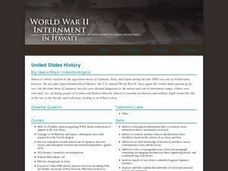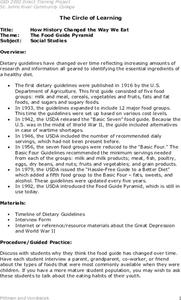National WWII Museum
What It Takes to Win: Mapping Primary Source Evidence
World War II was not just waged in Europe and Asia; the home front was key to Allied victory. Using newspaper clippings from World War II and a map, scholars plot out wartime production in the United States. After that, class members...
Agriculture in the Classroom
Growing a Nation (1950-1969): Prosperity & Challenges: The Story of American Agriculture
A wonderful instructional activity on the development and impact of mechanized farming! History or agriculture classes learn the historical background of the United States' food production by creating a pamphlet with information on the...
Curated OER
The American Home Front During WWII
Students analyze World War Two era government propaganda, biographies, and historical data in order to better understand the effects on Americans at home. In this American Home Front During World War Two lesson plan, students compare...
Curated OER
Pitching Patriotism
Students analyze the use of color, images and type used in print advertising, then "pitch" a company. They, in groups, brainstorm products and services of companies that may be affected by the war in Iraq.
Curated OER
Children of War
Young scholars discuss children's rights during wartime and watch public service announcements. After reading excerpts from children's diaries of war, they work in groups to create a storyboard for their own PSA on children's rights...
Curated OER
Remembering WWII Through Memorials
Learners create memorials for lesser known WWII heroes. In this WWII lesson, pupils recognize the efforts of lesser know individuals and groups that contributed to the wartime cause. Learners work in groups to create a memorial for one...
Curated OER
World War II: Internment in Hawaii
Students examine world history by writing an essay in class. In this World War II lesson, students identify the attack on Pearl Harbor, the response from the U.S and the effect it had on Japanese-Americans. Students define Japanese...
Curated OER
Wives and Mothers in WWII
Eighth graders explore the effect of World War II from a financial standpoint. In this World History lesson, 8th graders review World War II through teacher lecture, reading and viewing pictures and cartoons, then discuss the hardships...
Curated OER
Causes of America's Great Depression
High schoolers identify principal causes of the Great Depression. They analyze causes including a decline in worldwide trade, the stock market crash, and bank failures and explain the legacy of the Depression in American society.
Curated OER
Women In Aviation
In this aviation lesson, students take an electronic field trip to the Aviation Museum of Kentucjy. In the process the lesson looks at women in aviation history. The focus is upon how they could be considered heroes or role models. The...
Curated OER
The Home Front (Circa 1863)
Students interpret historical evidence presented in primary and secondary resources. In this American Civil War instructional activity, students examine sources and then write personal accounts of the war.
Curated OER
How History Changed the Way We Eat
Students participate in a lesson that is concerned with the history of the food pyramid and how it evolved and changed into its modern state. After being presented with the information they conduct classroom discussions about the research.
Curated OER
Mongolia: Land, History and Culture
Middle schoolers examine the land, culture and history of Mongolia. In groups, they use the internet to determine what groups held power and during what time periods. They also identify the most important parts of their culture and why...














